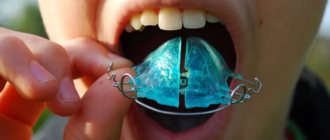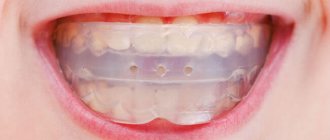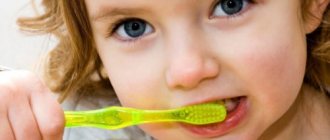Types of anesthesia in pediatric dentistry
Modern dental technologies are very diverse.
Hypnosis, musical sound analgesia, laughing gas, electroanesthesia, and infiltration anesthesia can be used as anesthesia for children during dental treatment. But more often they use methods based on proven medications and compounds. Protocols can be classified according to a variety of criteria. General gradation:
- local anesthesia;
- Oxygen sedation;
- deep sedation;
- general anesthesia.
There are also different methods of how dental anesthesia is given to children:
- topical anesthesia - smearing the gums with an anesthetic to locally “freeze” the nerve endings;
- injection anesthesia - administration of the drug using a carpule syringe with a particularly thin needle;
- mask for children - used in dentistry to administer anesthesia or a nitrogen mixture.
The names of drugs for pediatric anesthesia during dental treatment deserve special mention. Most often this is:
- Sevoran for general anesthesia is a highly effective inhalation anesthetic with the highest safety profile.
- Propofol for deep sedation is a completely safe composition for intravenous anesthesia.
The method of pain relief is selected taking into account the patient’s age, indications for use, and the amount of planned dental work.
Local anesthesia in dentistry for children
Local anesthesia is an anesthesia that temporarily blocks the transmission of nerve impulses. This means that during the treatment the child does not feel pain or discomfort. Dentists use local anesthetics as medications, selecting the composition after determining the patient’s allergic reactions.
Local anesthesia for children's teeth is usually carried out in two stages:
- application - for primary reduction of sensitivity;
- injection - administration of an anesthetic composition through an injection of an anesthetic.
Anesthesia for the treatment of baby teeth in very young patients takes place in three stages. The first is application “freezing”. The second and third are injection anesthesia. The first injection of anesthetic is performed with a minimum dose, a drop. Anesthesia takes effect almost immediately, after which the entire volume of the drug is administered.
Rodikova Tatyana
With children 3-4 years old we usually play a fairy tale - based on Frozen or invent our own. First, we smear the gums with “magic ice jam”, then we cast a spell like Elsa “to freeze microbes.” And after that we “make Olaf the snowman” or simply “freeze everything around.” Kids are happy to listen and help, which eliminates tears and whims during dental treatment.
How to prepare a child for dental treatment under anesthesia
- Before treatment, you should consult with an anesthesiologist. This can usually be done over the phone, but in some cases a face-to-face appointment is required.
To correctly administer general anesthesia, the anesthesiologist will need the following information:
- child development history;
- allergic reactions;
- past acute and chronic diseases;
- previous medical interventions and hospitalizations;
- anthropometric data (age, height, weight).
To clarify the child’s health status, you will need to undergo a series of tests. The anesthesiologist determines the full scope of the required examination based on the characteristics of the small patient and the type of upcoming treatment.
- Before anesthesia, diet is very important. The safety of anesthesia depends on its compliance.
The child who will best tolerate anesthesia is the one who:
- did not eat “heavy food” during the 6 hours preceding treatment;
- 4 hours before the procedure I had a snack;
- I drank water 2 hours before.
Dietary recommendations may vary, so the final meal plan will be discussed in consultation with the anesthesiologist.
- To help parents not be nervous, I also recommend asking the anesthesiologist what his qualifications are and what equipment he will use during the procedure. You definitely shouldn’t be embarrassed about such questions. Doctors with experience in pediatric anesthesiology should work with children, since the structure of the child’s body and its functioning have their own characteristics.
Oxygen-nitrogen sedation
ZAX is a mixture of oxygen and nitrous oxide, often known as laughing gas. Served through a mask. After inhaling the gas, the child falls into a relaxed, sleepy state, calmly perceives the surrounding reality, hears and understands speech addressed to him.
- maintains a positive mood - at the same time as treatment, the child watches cartoons and gets great pleasure from it;
- neutralizes pain - the pain threshold increases, which allows you to endure dental treatment comfortably and calmly;
- reduces natural reactions - the child is no longer frightened by bright lamps and the buzzing of the drill.
Superficial ZAX sedation is recommended for patients over three years of age and, with an experienced doctor, can replace pediatric anesthesia during dental treatment.
What is rehabilitation like after treatment under anesthesia?
After waking up from anesthesia, in the vast majority of cases, children feel well. Most often, the only thing that bothers them is numbness in the areas where the local anesthetic was injected.
As for behavioral changes, there are three types:
- excitement - the baby may be capricious and cry. This is accompanied by increased activity. But it quickly gives way to fatigue;
- fatigue - the child wants to sleep, refuses to eat, sits in the arms of the parents;
- no behavioral changes after waking up.
The first two scenarios are typical for children under the age of 7-10 years, the third - for adolescents and adults.
Hyperactivity and agitation upon awakening are unpleasant for both the child and those around him. To avoid it, we try to implement the second scenario; to do this, we put the baby to sleep and wake him up gently.
The child can eat immediately after waking up, unless the anesthesiologist gives other recommendations.
Very rarely, recovery from anesthesia is accompanied by nausea or a feeling of motion sickness. This lasts no longer than 2-3 hours. This reaction is typical for children who get motion sickness in transport. In this case, you will be able to eat and drink within an hour or after the nausea has passed.
There is no need to worry about the postoperative period - the anesthesiologist will always be in touch.
Deep sedation with Propofol - drug-induced sleep
During dental treatment, anesthesia for children or deep sedation may be used. These concepts are often confused, since in both cases the child is immersed in medicated sleep. But the difference is significant:
- General anesthesia in dentistry is given to children through a mask. Artificial sleep is as deep as possible, with complete loss of sensitivity.
- Sedation with Propofol involves intravenous administration of the drug and requires additional pain relief.
Propofol guarantees:
- natural physiological state of sleep;
- falling asleep in 1-2 minutes;
- exceptionally high safety for the child;
- simple awakening and rested state;
- extremely low risk of allergic reactions and side effects.
The quality and depth of sleep is controlled by an anesthesiologist. At this time, dentists treat and save teeth, remove completely destroyed units, and install prosthetic structures.
Rubber dam system for general anesthesia
Under conditions of general anesthesia, the patient's oral cavity remains open for a long time, which increases the risk of drying out the mucous membrane and developing stomatitis. The rubber dam system allows you to avoid such a scenario and speed up manipulations. It isolates the mucous membrane from the effects of irritating drugs, prevents burns and accidental ingestion or entry of small instruments into the respiratory tract.
The system can be fixed to the entire dentition or to a quadrant - the patient does not need to keep his mouth open all the time. In this condition, dentists still have a wide field of view and can work on multiple teeth.
Deep sedation with Propofol - drug-induced sleep
Dental anesthesia for children
Dental treatment for young children under anesthesia raises the maximum number of questions among adults. The main ones relate to the safety of the procedure and side effects. Parents are also interested in what kind of anesthesia they give their children during dental treatment - whether there are high risks of negative consequences.
Is anesthesia harmful for dental treatment for children?
Sevoran is a non-narcotic, non-toxic, completely safe drug that is used in dentistry for treatment under general anesthesia. It is given to the child through a mask, instantly putting him to sleep.
Among the advantages of the drug, confirming its safety for young patients:
- excreted from the body unchanged;
- does not affect internal organs;
- does not depress the heart;
- maintains physiological blood pressure readings.
Sevoran simply turns off consciousness and does not cause side effects. Additional positive points:
- pain relief - doctors do not administer additional drugs to the child;
- pleasant smell - children themselves breathe through the mask with pleasure;
- quick recovery from anesthesia - awakening takes only 10-15 minutes.
The high quality of the composition ensures that the use of anesthesia for dental treatment for children eliminates any unpleasant consequences.
Anesthesia at the dentist for children: features
Having figured out whether it is possible to treat a child’s teeth under general anesthesia, parents begin to prepare the child for the procedure.
To do this, the young patient is prescribed a series of examinations:
- Consultation with a dentist.
The doctor must assess the amount of work - determine caries, pulpitis, and the intensity of tooth destruction. Together with the parents, a decision will be made on how many teeth to treat, what to remove, and whether prosthetics are necessary. - Testing, primary diagnostics.
The basic set of studies is general and biochemical blood tests, electrocardiogram (ECG).
- Obtaining permission from a pediatrician.
If there are chronic diagnoses, the child is also sent for a consultation with a specialized specialist in order to eliminate any risks during dental treatment.
When all issues are agreed upon, the doctor sets a date for treatment and gives final recommendations.
Soldatenkova Alina
When removing baby teeth, it is very important to preserve space for future permanent ones. To do this, they either undergo prosthetics or go to an appointment with an orthodontist to install an orthodontic seat holder.
Pediatric anesthesiology is a separate branch of anesthesiological science. Approaches to anesthesia for children are generally similar to those for adult patients, but at the same time, there are very significant differences in certain issues. Considering that specialization in anesthesiology implies the ability of a doctor to provide anesthesia to a patient of any age, we believe that this article may be useful for doctors who mainly work with adult patients, but periodically encounter children in their practice.
Anatomical and physiological features strongly depend on the age of the child, and the older the child, the fewer these features become. A special group consists of newborns and children under one year of age, since this category of patients has many nuances. It should be understood that a child is not an adult of miniature size and weight, so you cannot limit yourself to just adjusting the doses of drugs used for pain relief. Each age of the child has its own specific characteristics, detailed information about which is available in the pediatric literature.
A preoperative examination of a child must necessarily include a medical history, including information about heredity and possible congenital pathology, as well as a history of the child’s growth and development. It is necessary to discuss in detail with the parents the choice of anesthesia, explain all the features, inform about possible complications and obtain written consent for anesthesia. If necessary, additional examination and consultation with specialists are prescribed. Assess the condition of the respiratory tract. The peripheral venous network is assessed for the possibility of catheterization of peripheral veins. Planned operations are postponed if the child has recently suffered a respiratory viral infection, has an exacerbation of chronic respiratory pathology or other pathology. It is necessary to give parents clear recommendations regarding the period of fasting before anesthesia, in accordance with the age of the child.
Necessary monitoring during anesthesia in children includes non-invasive blood pressure measurement, pulse oximetry, EC monitoring, gas monitoring, and body temperature monitoring. If necessary, this can be supplemented with advanced hemodynamic and other monitoring.
For anesthesia in children, general anesthesia, regional anesthesia, and a combination of these can be used. It is necessary to understand that a child under the age of 15 inclusive should not be present at his own operation, therefore the use of regional techniques is combined with general anesthesia or deep sedation. Regional anesthesia in children includes spinal, epidural, caudal, and conduction anesthesia. When performing peripheral regional blockades, ultrasound navigation and a neurostimulator should be used, which can significantly reduce the required amount of local anesthetic, speed up the blockade, make it less traumatic and reduce the number of complications. All peripheral regional blocks in children should be performed under deep sedation or general anesthesia.
General anesthesia in children usually includes mask and laryngeal-mask anesthesia, as well as general endotracheal anesthesia. In planned pediatric anesthesiology for short-term interventions, mask anesthesia with inhalation anesthetics (sevoflurane) is widely used while maintaining spontaneous breathing. Laryngeal mask anesthesia is performed for longer operations. For long-term interventions requiring the use of muscle relaxation, general endotracheal anesthesia with tracheal intubation and artificial ventilation is used. When performing emergency operations on children, given the danger of a full stomach and aspiration complications, general endotracheal anesthesia is also used.
In some situations, general intravenous anesthesia may be used in children, when intravenous anesthetics are administered through venous access directly into the bloodstream, while monitoring the patency of the upper respiratory tract and respiratory support is mandatory.
After the operation, the child awakens on the operating table, or, if necessary, is transferred to the intensive care unit for prolonged artificial ventilation in the postoperative period. If the child awakens on the table and does not require transfer to the intensive care unit, then after completion of anesthesia he is transferred to the recovery room, where he remains until recovery from anesthesia under the supervision of an anesthesiologist and nurse anesthetist.







